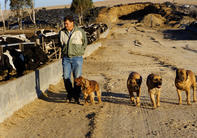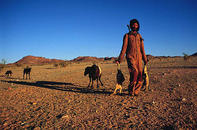Domestic dogs (Canis familiaris) may cause extensive damage on livestock farms. Some people think it is only hungry stray dogs that cause damage, but in reality, it often is well-fed family pets, small and large, that go onto killing sprees.

The dogs can be anything from a pavement special to Jack Russel or Boerboel, with the destruction worsened when they operate in packs. Dogs can walk kilometres to catch animals and sow destruction. Many folk are often unaware of the no-good their dogs are up to.
Even in Cape Town, there have been reports of dogs forming packs and sowing destruction on Table Mountain while their owners are away at work. Predation by dogs is especially a problem when farms are close to residential areas.
Killing and Feeding Pattern
Dogs are extremely vicious predators. They tear and bite their prey randomly, with no fixed pattern. There will typically be lots of tracks, as dogs like to chase and bite their prey while running alongside them. Small lambs are often bitten on the chest, back or head, while large lambs or sheep are bitten anywhere on the body.
Bites may also be seen on the hamstrings, head, ears, neck or flanks of the prey. The kill is generally untidy – seldom clean and neat like that of a natural predator – with the carcass often being dragged to and fro. The damage is also generally extensive, with several animals being maimed or killed.
Footprints are often confused with those of a cheetah, but the rear part of the footpad lacks the typical W-shaped grooves of the cat family. The amount of meat eaten varies, from hardly anything to large amounts.
Feeding is often from the rear end, with large pieces of meat being ripped from the carcass. Large bones will be chewed or eaten and chunks of wool may be scattered everywhere. Large pieces of skin may also be torn from the prey.
Management

Electric fencing is the best preventative measure against dogs. If animals are put in a kraal or in cages, in the case of chickens, special care should be take to ensure the dogs cannot enter it by going over or underneath the fence. When problems occur, it is best to involve the Society for the Prevention of Cruelty to Animals (SPCA).
To prevent farm dogs from turning into a problem, they should be enclosed at night, fed correctly and not be allowed to wander unsupervised on the farm. Stray dogs can be caught with cage traps. A farmer has the legal right to shoot a dog on his own farm in order to protect his livestock.